BestReviews is reader-supported and may earn an affiliate commission. Details

A step up from most of the battery operated toy models for kids.
A step up from most of the battery operated toy models for kids.
Rubber tires like a real, adult model. Holds up to 120 pounds. Goes faster than other kids' models at up to 9.5 mph. Quiet operation. Battery lasts for a good amount of time. No problems on rough terrain or inclines. Easy to operate.
While the manufacturer officially recommends this for teens. It will likely be too small for most teens to enjoy and is better for pre-teen children.
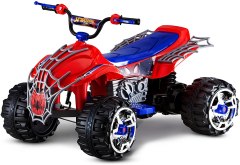
A great looking model that will keep your child entertained for a long time.
A great looking model that will keep your child entertained for a long time.
Multiple driving speeds allow your child to choose what they feel comfortable with. Top speed is 5 mph, so it will be easy to catch them if need be. Plastic wheel with rubber strip allows for good traction.
Only able to hold up to 88 pounds. Can be difficult to assemble.
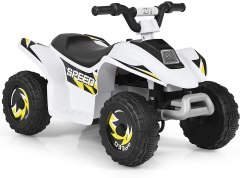
A slower option for younger children who haven't ridden anything before.
A slower option for younger children who haven't ridden anything before.
Slower speeds will allow your young one to get comfortable riding. Easy to control with switches on the handlebars. High-quality seat to ensure they are comfortable on longer rides. Runs for 2 hours
The low power and plastic tire combination wont allow it to drive on grass or slippery surfaces.
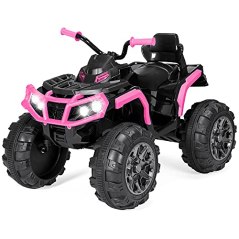
A rugged choice with hot pink flair for little drivers up to about 66 pounds.
A rugged choice with hot pink flair for little drivers up to about 66 pounds.
Easy for kids to drive. Has forward, reverse, and two speed choices. Accommodates media devices so driver can listen to music. Cool LED headlights and horn. Wheels with large tread can take on dirt, grass, concrete.
The vehicle may have difficulty on steep hills.
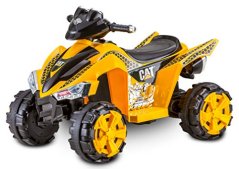
A low power option that is suitable for the littlest riders and doesn't go very fast.
A low power option that is suitable for the littlest riders and doesn't go very fast.
Working headlights. Max speed 2.5 mph, which is good for little ones. 6V battery. Goes together quickly. Rubber grips on the tires. Buttons for engine sound and horn sound. Battery lasts a long time.
This is a rather small model. Children will outgrow it quickly.

We recommend these products based on an intensive research process that's designed to cut through the noise and find the top products in this space. Guided by experts, we spend hours looking into the factors that matter, to bring you these selections.
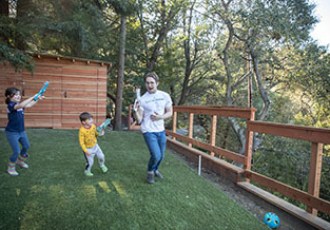
Your first pair of wheels usually won't require a driver’s license or even a key to operate. Perhaps it isn’t even meant for the road, preferring to roam the grassy, dirty outdoors in favor of the path most traveled. Yes, we’re talking about youth ATVs, which can be a fun introduction to driving before driving for real. Adults shouldn’t have all the fun, right?
Compared to normal ATVs, youth ATVs are meant for pre-teens and younger kids and are significantly scaled down in terms of size and performance. These include self-powered ATVs with pedals, ATV-style electric Power Wheels, and larger battery-powered units that can reach speeds approaching 10 mph. You won’t find combustion engines, complex suspensions, or fancy off-road tires, but youth ATVs still offer similar benefits to those of “grown-up” versions.
Youth ATVs can improve motor skills and coordination, and when shared with friends or siblings, they can present unique bonding experiences. In addition, driving a small ATV promotes healthy driving habits, spatial awareness, and a sense of responsibility for an expensive machine that needs special care.

Youth ATVs come in all shapes and sizes. It’s a fairly broad category, ranging from diminutive push-powered models all the way to pre-teen-rated vehicles with multiple batteries and functioning suspension. It’s an important safety concern to size yours properly because if you get an ATV that is too large, the rider may not be able to reach all the controls properly. If it’s too small, they won’t be able to balance on it properly and could potentially fall off. If you’re confused about what size is best for your child, keep in mind that every youth ATV should have age limits and weight limits.
For reference, youth ATVs on the smaller side average around 2.5 feet long, 1 foot wide, and 1.5 feet tall. These are generally plastic versions without suspension or real tires. Larger units with real rubber tires and proper suspension measure approximately 4 feet long, 2 feet wide, and 2.5 feet tall.
While it would be a stretch to call any youth ATV fast, there is a large discrepancy in speed between beginner models and those for pre-teens. Like size, speed is an important safety consideration because you don’t want to give your child something they can’t control. It’s the same reason why driving a Ferrari for your first car generally isn’t a great idea.
The slowest and most controllable youth ATVs are self-powered, as they won’t go much faster than 1 mph so long as you avoid hills. The only batteries in these versions are used to power lights, horns, or other novelty features. Mid-size ATVs have small batteries, usually 6V, and top out anywhere between 2 and 6 mph. Some models offer a “high gear” mode, allowing the vehicle to reach slightly higher speeds after the rider gets comfortable. Finally, at the top of the range, larger youth ATVs will equip 2 12V batteries for speeds around 10 mph. These models often have disc brakes to help with deceleration.

What youth ATVs lack in pure adrenaline, they make up for with creative designs and interactions. These mini quads are commonly fitted with headlights, dash lights, horns, and speakers that play a variety of tones, including chimes, sound effects, and engine noises. Some even play original songs and talking phrases.
A basic youth ATV aimed at kids around 6 years old will generally have hard plastic tires with grooves for traction. These don’t have much flex or shock absorption, but these ATVs aren’t fast enough to need much. That said, there are youth ATVs with proper knobby rubber tires, which allow the vehicle to tackle grass, dirt, and mud significantly easier. In between the two options are hard plastic tires with rubber strips for traction. For many, these represent a decent middle ground.
Depending on where on the toy-to-actual-vehicle spectrum your youth ATV lies, it may have a proper suspension setup or no suspension at all. Basic units like these basically sit on a rigid plastic frame, thus the wheels don’t move up or down with terrain at all. More serious models, however, often boast ground-tracing droop-travel rear suspension with coil shocks to deliver a smooth, responsive ride over rough ground. As you might have guessed, these models are significantly more expensive.
Storage is helpful in any vehicle, and even though a youth ATV doesn’t need to haul tools, spare tires, or other supplies, a little extra space certainly can’t hurt. It might be juice boxes and gummy bears in this case, but models with helpful storage compartments (like trunks or frunks), can have an edge over the competition.

Entry-level youth ATVs start at about $50. For the money, you’ll be looking at small, plastic-frame units for younger kids. Although self-powered models are aplenty here, you can find small battery-powered units as well — generally the 6V variety.
At $100 to $150, you’re still in the plastic frame (no suspension) category, but these models often have larger 12V batteries, higher speeds, and additional features.
The top range for youth ATVs takes a big jump up into the $450 to $500 range. These ATVs closely resemble adult models but are battery-powered and typically don’t exceed 12 mph. They do, however, fit proper suspensions with coil shocks. Small combustion engine variants are rare in this segment, but you may find one if you look hard enough.
The majority of youth ATVs are powered by batteries, and this requires special care. To extend the life of your battery, avoid storing the ATV in temperatures under -10ºF or over 80ºF. This might mean bringing it inside during winter.
Youth ATVs generally list recommended age ranges as well as weight limits. Use these limits to help you choose, but consider the fact that your child may outgrow their ATV quite quickly. Choosing a larger unit and waiting may be the safest plan.
As tempting as it may be, never allow more than the recommended number of riders on a youth ATV. Exceeding the weight limit can cause damage to the vehicle or lead to injuries. There’s also a higher risk of tipping.

A. Much like traditional ATVs, youth ATVs are not legal for road use. There are several reasons for this — engine emissions not reaching standards, no proper safety equipment, no turn signals, and no mirrors, to name a few. In general, they’re safest when used on your own property. They can be used on sidewalks and other non-motorways, but we strongly recommend supervision whenever doing so.
A. Youth ATVs do not travel at high speeds, but safety gear is never a bad choice. For models that exceed 4 mph, we recommend a strong helmet at a bare minimum, but elbow pads, knee pads, and goggles are always good options. For ATV with top speeds closer to 10 mph, such as those with one or more 12V batteries, consider helmets with face shields, pads, gloves, boots, long pants, and possibly even a chest protector. You can never be too safe.
A. When ordering a youth ATV online, it will likely arrive partially assembled. You can usually put them together in less than an hour with a screwdriver. Generally, the process involves attaching each of the wheels to the axles, attaching the handlebars and steering assembly, connecting the gearbox, and connecting various plugs relating to the battery. After that’s done, you may need to fully charge the battery before it’s ready to ride. This can take 12 hours or more, but that gives you plenty of time to add decals, stickers, or custom parts.
Get emails you’ll love.
Learn about the products you’re wondering if you should buy and get advice on using your latest purchases.
